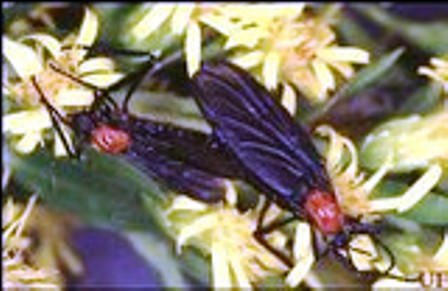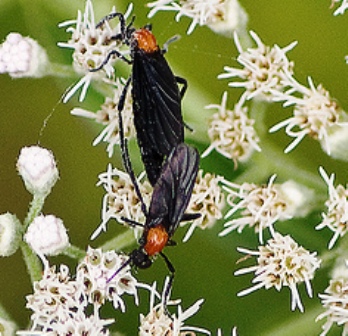Discover Florida Nature
It's time to explore the natural Florida


|
|
|
|
|
 'Lovebugs'(plecia
nearctica hardy) are small black flies with red thoraxes. Lovebugs vary
in length from one quarter to one third inch. Lovebugs do not sting or
bite, but they do make a mess on motorist's windshields! Lovebugs are
members of the family Bibionidae and are known as March flies. Several
species of March flies are native to Florida, however Lovebugs, are
recent invaders from the west. First reports of their presence in
Florida were made in 1947 from Escambia County. Subsequent reports
indicate lovebug presence in Leon County in 1955-56 and Alachua - Marion
Counties in 1964-65. Since that time, lovebug flights have progressively
moved southward. In 1974, specimens were collected in Homestead.
Lovebugs also have moved northward and have been reported from Georgia
and Charleston, South Carolina. 'Lovebugs'(plecia
nearctica hardy) are small black flies with red thoraxes. Lovebugs vary
in length from one quarter to one third inch. Lovebugs do not sting or
bite, but they do make a mess on motorist's windshields! Lovebugs are
members of the family Bibionidae and are known as March flies. Several
species of March flies are native to Florida, however Lovebugs, are
recent invaders from the west. First reports of their presence in
Florida were made in 1947 from Escambia County. Subsequent reports
indicate lovebug presence in Leon County in 1955-56 and Alachua - Marion
Counties in 1964-65. Since that time, lovebug flights have progressively
moved southward. In 1974, specimens were collected in Homestead.
Lovebugs also have moved northward and have been reported from Georgia
and Charleston, South Carolina. Lovebug flights can number in the hundreds of thousands. The slow, drifting movement of the lovebug is almost reminiscent of snow fall. Two major flights occur each year, first in late spring, then again in late summer. In south Florida, a third (but smaller) flight can occur in December. The spring flight occurs during late April and May, the summer during late August and September. Flights extend over periods of four to five weeks. Mating takes place almost immediately after emergence of the females. Adult female lovebugs live only 2-3 days. Females lay up to 350 eggs, which are deposited beneath decaying vegetation, and about 20 days later the eggs hatch into larvae. The larval stage may last up to nine months. For most of the year, lovebugs are beneficial in that the larvae (maggots) live in grassy areas and feed on dead vegetation within the thatch. This results in not only the eventual release of nutrients back into the soil, but also decreases excessive thatch which can be detrimental to grass growth and serve as a protective cover for serious grass pests. After larvae mature, they transform into pupae. The pupal stage requires about 7 to 10 days. The adult lovebug feeds on the nectar of flowering plants. Upon reaching maturity the lovebug spends almost the entirety of its remaining life copulating with its mate, hence its numerous romantic nicknames. The male and female lovebugs attach themselves at the rear of the abdomen and remain that way at all times, even in flight. In fact, after mating, the male dies and is dragged around by the female until she lays her eggs.  Lovebug
adults are attracted to light-colored surfaces, especially if they are
freshly painted, but the adults can congregate almost anywhere by
reacting to the effects of sunlight on automobile fumes, asphalt, and
other products affected by environmental factors still not completely
understood. Lovebug
adults are attracted to light-colored surfaces, especially if they are
freshly painted, but the adults can congregate almost anywhere by
reacting to the effects of sunlight on automobile fumes, asphalt, and
other products affected by environmental factors still not completely
understood.The lovebugs reputation as a public nuisance is due not to any bite or sting, but to its slightly acidic body chemistry. Because airborne lovebugs can exist in enormous numbers near highways, they die en masse on automobile windshields, hoods, and radiator grills when the vehicles travel at high speeds. If left for more than an hour or two, the lovebug remains become dried and extremely difficult to remove. Splattered lovebugs should be washed off the car as soon as possible. Cars that have been waxed recently are more protected from damage by lovebug residue. Soaking the area with water for several minutes will aid in removal too. When lovebugs are numerous, or you know you will be traveling at the peak times, you can spread a light film of baby oil or use an aerosol oil spray over the front of the hood, above the windshield, and the grill and bumper. This practice will make lovebug removal easier. Urban legend holds that lovebugs are synthetic — the result of a University of Florida genetics experiment gone wrong. Speculation about the lovebug abounds. This is partly due to the fact that lovebugs are an unseen beneficial (lives and feeds in the thatch of grasses) for most of the year. As a result, most scientists are not as concerned with the details of this insect's life cycle, biology and other facets of its existence as they are with more serious pests. Research of L. L. Buschman showed that migration explained the introduction of the lovebug into Florida and other southeastern states, contrary to the urban myth that the University of Florida created them by manipulating DNA to control mosquito populations. |
|
|
Advertise | Privacy Statement | Dog Encyclopedia | Video |Contact | Alaska Nature |
|